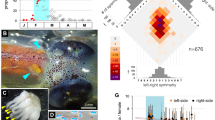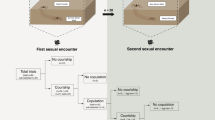Abstract
REPRODUCTIVE competition for females among males of a given species can take many forms, some of which (like mating plugs) may place constraints on the mating opportunities of males and intensify competition for available females. I have studied the reproductive behaviour of two garter snake species (Thamnophis sirtalis and T. butleri) in the field for 5 years. They do not exhibit pair-bonding, paternal care of offspring, territoriality, or intrasexual combat. Sexual selection in this mating system should favour males which compete to locate, court and mate with the maximum number of females1. Yet I have observed numerous solitary female Thamnophis within the same time periods and areas in which other females were being vigorously courted, often by several males. I have previously observed that the anterior cloaca of any recently mated female Thamnophis contains a copulatory plug which occludes the oviductal orifices2. The plug evidently is formed by the copulating male after sperm transfer. I interpreted this as a form of intrasexual competition in which the successfully copulating male makes the female temporarily unavailable to other males and reduces the likelihood of multiple inseminations. Some reports3,4 indicate that multiple inseminations are possible. I present here evidence from the field that male garter snakes recognise females with a copulatory plug and behave as if these females were unavailable.
This is a preview of subscription content, access via your institution
Access options
Subscribe to this journal
Receive 51 print issues and online access
$199.00 per year
only $3.90 per issue
Buy this article
- Purchase on Springer Link
- Instant access to full article PDF
Prices may be subject to local taxes which are calculated during checkout
Similar content being viewed by others
References
Trivers, R. L. in Sexual Selection and the Descent of Man 1871–1971 (ed Campbell, B.) 136–179 (Aldine, Chicago, 1972).
Devine, M. C. Science 187, 844–845 (1975).
Blanchard, F. N. & Blanchard, F. C. Pap. Mich. Acad. Sci. Arts Lett. 26, 177–193 (1941).
Gibson, A. R. & Falls, J. B. Can. J. Zool. 53, 1362–1368 (1975).
Gregory, P. T. Can. J. Zool. 52, 1063–1069 (1974).
Aleksiuk, M. & Gregory, P. T. Copeia 681–688 (1974).
Hawley, A. W. L. & Aleksiuk, M. Can. J. Zool. 53, 768–776 (1975).
Aleksiuk, M. Copeia 170–178 (1976).
Gardner, J. B. Copeia 48 (1957).
Ruthven, A. G. Biol. Bull. 24, 18–20 (1912).
Noble, G. K. Bull. Am. Mus. nat. Hist. 73, 673–725 (1937).
Blanchard, F. N. & Blanchard, F. C. Pap. Mich. Acad. Sci. Arts Lett. 27, 215–234 (1942).
Author information
Authors and Affiliations
Rights and permissions
About this article
Cite this article
DEVINE, M. Copulatory plugs, restricted mating opportunities and reproductive competition among male garter snakes. Nature 267, 345–346 (1977). https://doi.org/10.1038/267345a0
Received:
Accepted:
Issue Date:
DOI: https://doi.org/10.1038/267345a0
This article is cited by
-
Comparative analysis of sperm motility in liquid and seminal coagulum portions between Bornean orangutan (Pongo pygmaeus) and chimpanzee (Pan troglodytes)
Primates (2021)
-
Correlated evolution of sexually selected traits: interspecific variation in ejaculates, sperm morphology, copulatory mate guarding, and body size in two sympatric species of garter snakes
Behavioral Ecology and Sociobiology (2017)
-
Genetic and phenotypic influences on copulatory plug survival in mice
Heredity (2015)
-
Factors influencing paternity in multiply mated female red-sided garter snakes and the persistent use of sperm stored over winter
Behavioral Ecology and Sociobiology (2014)
-
Effect of photoperiod on characteristics of semen obtained by electroejaculation in stump-tailed macaques (Macaca arctoides)
Primates (2014)
Comments
By submitting a comment you agree to abide by our Terms and Community Guidelines. If you find something abusive or that does not comply with our terms or guidelines please flag it as inappropriate.



